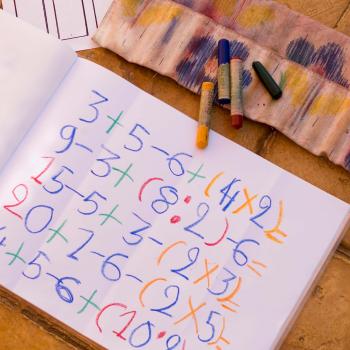A-B-C: It's Easy as 1-2-3 to Make Math Alphabet Books

- Preview |
- Standards |
- Resources & Preparation |
- Instructional Plan |
- Related Resources |
- Comments
Overview
In this lesson, students write math alphabet books for each other to review math terminology. They publish their books using the Alphabet Organizer app and then share their new books with their classmates.
Featured Resources
Alphabet Organizer app: Students will use this free app to create alphabet books to illustrate math terms.
From Theory to Practice
Larson, Dix, and Townsend believe that providing opportunities for students to practice academic vocabulary is invaluable. They predict such vocabulary exercises will ensure students achieve academic success. They also suggest that vocabulary instruction must be active and engaging for students to “buy-in” to the importance of learning new words and concepts. Likewise, Collier states that students must be engaged “in meaningful and varied activities to help cement these words into long-term memory” as well as to make connections to what they already know. This lesson provides a unique method to review math content vocabulary, and it integrates technology so that students can become proficient with the tools of technology as supported by the NCTE Definition of 21st Century Literacies.
Common Core Standards
This resource has been aligned to the Common Core State Standards for states in which they have been adopted. If a state does not appear in the drop-down, CCSS alignments are forthcoming.
State Standards
This lesson has been aligned to standards in the following states. If a state does not appear in the drop-down, standard alignments are not currently available for that state.
NCTE/IRA National Standards for the English Language Arts
- 1. Students read a wide range of print and nonprint texts to build an understanding of texts, of themselves, and of the cultures of the United States and the world; to acquire new information; to respond to the needs and demands of society and the workplace; and for personal fulfillment. Among these texts are fiction and nonfiction, classic and contemporary works.
- 3. Students apply a wide range of strategies to comprehend, interpret, evaluate, and appreciate texts. They draw on their prior experience, their interactions with other readers and writers, their knowledge of word meaning and of other texts, their word identification strategies, and their understanding of textual features (e.g., sound-letter correspondence, sentence structure, context, graphics).
- 4. Students adjust their use of spoken, written, and visual language (e.g., conventions, style, vocabulary) to communicate effectively with a variety of audiences and for different purposes.
- 5. Students employ a wide range of strategies as they write and use different writing process elements appropriately to communicate with different audiences for a variety of purposes.
- 6. Students apply knowledge of language structure, language conventions (e.g., spelling and punctuation), media techniques, figurative language, and genre to create, critique, and discuss print and nonprint texts.
- 8. Students use a variety of technological and information resources (e.g., libraries, databases, computer networks, video) to gather and synthesize information and to create and communicate knowledge.
- 11. Students participate as knowledgeable, reflective, creative, and critical members of a variety of literacy communities.
- 12. Students use spoken, written, and visual language to accomplish their own purposes (e.g., for learning, enjoyment, persuasion, and the exchange of information).
Materials and Technology
- Tablets
- One computer with LCD projector and adapter to connect tablets to this computer
- Paper to print books (optional)
- Printer (optional)
Printouts
Websites
This website offers definitions for math terms, divided by grade level. Students will find definitions with some illustrations.
This PBS sponsored website has easy-to-understand definitions for a short list of math terms.
This website features an alphabetical list of math terms that students may refer to when they have difficulty finding a term for each letter of the alphabet.
Preparation
- Download the Alphabet Organizer app on the tablets the students will be using. Familiarize yourself with the app. Alternately, if tablets are not available, use Alphabet Organizer online interactive.
- Using the Alphabet Organizer app, create one page of the alphabet book featuring one math term or use the Math Terms Sample in the printouts.
- Make one copy for every student of the printouts Math Alphabet Book Rubric, Math Book Planning Sheet, and Math Terms Listening Sheet.
- Post the websites to a class wiki or website, or bookmark them on the tablets. If none of those choices is possible, make copies of the printout Math Terms Web Sites.
Student Objectives
Students will
- define self-selected math terms.
- illustrate math terms with images.
- apply the definition of math terms as shown by providing examples of their usage.
- create an alphabet book using a mobile app.
Session 1
- Divide students into groups of three or four. In their groups, instruct students to list all the math terms they can remember.
- When students have had ample time to recall math terms, call the class back together and project the Math Book Planning Sheet. As students share what terms they listed, write the terms on the Math Planning Sheet by the corresponding letter.
- After all responses have been recorded, explain to the students that they will be creating math alphabet books for each other to reinforce math terms. For each letter of the alphabet, they will create a page that has a math term, its definition, an example of its use in the world, and an image.
- Show the students the sample you created or the Math Terms Sample. Hand out the Math Alphabet Book Rubric and ask students to evaluate the sample using the rubric.
- Hand out the Math Book Planning Sheet. Give students time to work on the sheet. Remind students that, as the rubric states, they are to write in complete sentences. Also, remind students that their audience for these books is each other, so the definitions need to be written in their own words, not just copied from a dictionary or website. For letters they have trouble thinking of a math term, have the students use the suggested websites.
- Assign the students to complete the Math Book Planning Sheet printout before the next session.
Session 2
- Check that all students have completed their Math Book Planning Sheet printouts. Assist those who might need extra help. Provide extra time, if needed, for students to use the websites for letters which they have no terms.
- Model for the students the three options for finding images for their terms:
- Show the students how to take photos using the tablets.
- Show the students how to find images online and save to the tablets.
- Tell the students they can also draw pictures and then use the tablets to photograph their illustrations.
- Allow students time to work on finding their images. Circulate throughout the classroom and note time on task as that is part of the rubric. Help students with the technology. Question students about why they have selected specific images for their terms.
Sessions 3 and 4
- Connect one of the tablets to the LCD projector, and model for students how to use the Alphabet Organizer app. Include the following points in your demonstration:
- Tell students to include their names in the project title so that when the files are e-mailed, it will be clear which book was written by which student.
- Tell them to choose the template on the right that says, “one word and one picture per letter.”
- Allow students time to create their alphabet books. As students work, assist those who are having trouble with the technology. Check that all students have found their pictures. Help those students who may be behind finding images. Check that students are writing the definitions of terms in their own words and in complete sentences.
- Observe student behavior and time on task as that is part of the rubric.
- Show students near the end of Session Three how to save their projects.
- At the end of the fourth session, instruct students to share their final project by e-mailing their books.
Session 5
- Hand out the printout Math Terms Listening Sheet. Explain to the class as others present they are to fill out this sheet. Suggest to the class they might like how well the student explained the term. They may enjoy another term because the image fits the definition extremely well.
- Have the students share their alphabet books with the class by connecting mobile devices to the LCD projector with an adapter.
- After each student is done, allow time for students to complete their charts as well as comment on each other’s examples and images.
- After all have presented, ask students to complete the reflective statements in the assessment section:
From this project I learned ___________________________.
This project could have been improved by ___________________. - Collect the Math Terms Listening Sheet and the students’ reflective statements.
Extensions
- If tablets are not available, students can create hard copies of their alphabet books or use the student interactive Alphabet Organizer if computers are available.
- This lesson can be shortened by assigning students to cover just one letter of the alphabet and one math term. Then the pages could be printed and assembled into a class book.
- Share the books with other classes in the school by printing the completed books.
- Post the books to a class wiki or website for all to view.
- Try the Alphabet Organizer app for other content vocabulary such as a science term alphabet book.
Student Assessment / Reflections
Possible student assessment include
- Use the Math Alphabet Book Rubric to assess students’ finished books.
- Ask the students to explain the relationship between the images they choose for their math terms.
- Read through the students’ completed printouts Math Terms Listening Sheet and Math Book Planning Sheet.
- Ask students to complete the following statements:
From this project I learned ___________________________.
This project could have been improved by ___________________.

Add new comment